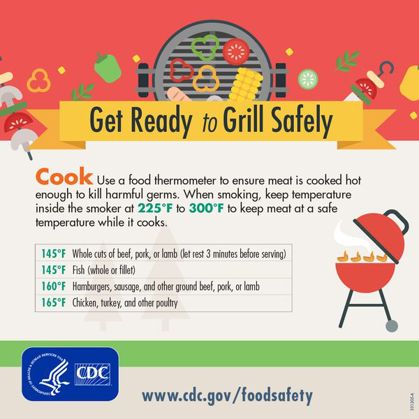Ways to Prevent Foodborne Illness
- Wash your hands with warm water and soap for at least 20 seconds before and after handling food and after using the bathroom, changing diapers and handling pets.
- Wash your cutting boards, dishes, utensils, and countertops with hot soapy water after preparing each food item and before you go on to the next food.
- Consider using paper towels to clean up kitchen surfaces. If you use cloth towels wash them often in the hot cycle of your washing machine.
- Rinse fresh fruits and vegetables under running tap water, including those with skins and rinds that are not eaten.
- Rub firm-skinned fruits and vegetables under running tap water or scrub with a clean vegetable brush while rinsing with running tap water.
- Use one cutting board for fresh produce or other foods that won’t be cooked before they’re eaten, and another for raw meat, poultry, or seafood. Replace them when they are worn.
- Use separate plates and utensils for cooked and raw foods.
- Use hot, soapy water to thoroughly wash plates, utensils, and cutting boards that touch raw meat, poultry, seafood, eggs, or flour.
- In your shopping cart, separate raw meat, poultry, seafood, and eggs from other foods and place packages of raw meat, poultry, and seafood in plastic bags if available. When you check out, place raw meat, poultry, and seafood in separate bags from other foods.
- At home, place raw meat, poultry, and seafood in containers or sealed leakproof plastic bags. Freeze them if you’re not planning to use them within a few days.
- In the fridge, keep eggs in their original carton and store them in the main compartment—not in the door.
Download Separate Fact Sheet Learn Separating Quick Tips (FDA)
- Use a food thermometer that measures the internal temperature of cooked meat, poultry and egg dishes, to make sure that the food is cooked to a safe internal temperature.
Cook roasts and steaks to a minimum of 145°F. All poultry should reach a safe minimum internal temperature of 165°F as measured with a food thermometer. Check the internal temperature in the innermost part of the thigh and wing and the thickest part of the breast with a food thermometer.

- Cook ground meat, where bacteria can spread during grinding, to at least 160°F. Information from the Centers for Disease Control and Prevention (CDC) links eating undercooked ground beef with a higher risk of illness. Remember, color is not a reliable indicator of doneness. Use a food thermometer to check the internal temperature of your burgers.
- Cook eggs until the yolk and white are firm, not runny. Don’t use recipes in which eggs remain raw or only partially cooked.
- Cook fish to 145°F or until the flesh is opaque and separates easily with a fork.
- Make sure there are no cold spots in food (where bacteria can survive) when cooking in a microwave oven. For best results, cover food, stir, and rotate for even cooking. If there is no turntable, rotate the dish by hand once or twice during cooking.
- Bring sauces, soups, and gravy to a boil when reheating. Heat other leftovers thoroughly to 165°F.
- Refrigerate or freeze meat, poultry, eggs and other perishables as soon as you get them home from the store.
- Never let raw meat, poultry, eggs, cooked food, or cut fresh fruits or vegetables sit at room temperature for more than two hours before putting them in the refrigerator or freezer (one hour when the temperature is above 90°F).
- Never defrost food at room temperature. Food must be kept at a safe temperature during thawing. There are three safe ways to defrost food: in the refrigerator, cold water, and the microwave. Food thawed in cold water or in the microwave should be cooked immediately.
- Always marinate food in the refrigerator.
- Divide large amounts of leftovers into shallow containers for quicker cooling in the refrigerator.
- Use or discard refrigerated food on a regular basis.
Download Chill Fact Sheet Learn Chilling Quick Tips (FDA) Download Storage Times Chart
Timeline for Identifying & Reporting Illnesses in Foodborne Outbreaks
Description of the event timeline for identifying and reporting cases in foodborne outbreaks. (CDC Video)


